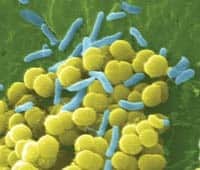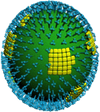Microbe Labs

Microbiology lesson plans designed for high school, middle school, and elementary school science teachers are downloadable here. NGSS Life Science offers many great science lessons. The following are a few examples. Microbiology experiments that student use stains for bacteria identification. Other microorganism labs include bacterial growth limits. A ciliate activity shows students how paramecium’s eat food. Disease projects include researching different disease causing viruses, protists and bacteria. Microorganism worksheets and exam / test / quiz questions also provide help with evaluating the student’s progress. Click the titles below to see a list of lessons for each category. Free microbiology curriculum includes:
-

Microbe Lab - Examine a pond water ecosystem Free Lesson Plan
Middle School Lab
Students examine pond water to determine abiotic factors (temperature, dissolved oxygen, pH) and biotic factors (microorganisms).NGSS Standard
HS-LS2-7
HS-LS4-6
MS-LS2-5 (Biodiversity)
Published by Shannan Muskopf
-

Microbe Lab - Biodiversity of Ponds Free Lesson Plan
Middle School Lab
Students will observe and record data from 3 samples of pond water. Students will identify organisms (protists, arthropods..etc) and numbers of organisms in each. Students will prepare a report that discusses the biodiversity of each sample.NGSS Standard
HS-LS2-7
HS-LS4-6
MS-LS1-4 (Animal Plant Structures)
MS-LS2-5 (Biodiversity)
Published by Shannan Muskopf
-

Parts of a Prokaryote Free Lesson Plan
High School Worksheet
Students read a short passage about prokaryotes and color in the different parts a bacteria cell. Students then answer 10 review questions about prokaryotes.NGSS Standard
MS-LS1-1 (Cell Types)
Published by Shannan Muskopf
-

How HIV Infects Cells - AP Free Lesson Plan
High School Worksheet
Students read about how HIV infects cells, answer 3 questions, and then color the virus / cell parts for 15 keywords.NGSS Standard
HS-LS1-2
MS-LS1-3 (HBS)
Published by Shannan Muskopf
-

Intro to Euglena Worksheet Free Lesson Plan
Middle School Worksheet
An introductory protozoan worksheet for students to learn about an Eugenia. Students answer question about an Eugenia's anatomy, physiology, and metabolic processes. Students also color the organelles of an Eugenia.NGSS Standard
MS-LS1-4 (Animal Plant Structures)
Published by Shannan Muskopf
-

Introduction to Paramecium Worksheet Free Lesson Plan
Middle School Worksheet
An introductory protozoan worksheet for students to learn about a Paramecium. Students answer question about a Paramecium's 's anatomy, physiology, and metabolic processes. Students also color the organelles of an Paramecium.NGSS Standard
MS-LS1-1 (Cell Types)
MS-LS1-4 (Animal Plant Structures)
MS-LS3-2 (Types of Reproduction)
Published by Shannan Muskopf
-

Intro to Amoebas Worksheet Free Lesson Plan
Middle School Worksheet
An introductory protozoan worksheet for students to learn about an Amoeba. Students answer question about an Amoeba's anatomy, physiology, life cycle, and issues affecting human health. Students also color the organelles of an Amoeba.NGSS Standard
MS-LS1-4 (Animal Plant Structures)
Published by Shannan Muskopf
-

Bacteria, Virus, & Multicellular Organisms Worksheet  Free Lesson Plan (PDF)
Free Lesson Plan (PDF)
Lesson Plan (DOCX) & Answer Key with Membership
Middle School Worksheet
In this microbe worksheet, students compare and contrast prokaryotes, eukaryotes and viruses. The purpose of this worksheet is for students to see the difference between single-celled organisms, multicellular organisms, and a virus.NGSS Standard
MS-LS1-1 (Cell Types)
Published by NGSS Life Science
-

Human Population Growth Lab - Spread of an Infectious Disease Free Student Handout
Free Teacher Notes
High School Lab
In this human population growth lab, students simulate the exponential growth of an infectious disease in a population. Students then discuss how human diseases spread and their exponential and logistic growth curves. Lastly, students graph the simulated results.NGSS Standard
HS-LS1-2
Published by Ingrid Waldron and Jennifer Doherty
-

Fungi Lab - Moldy Jell-O Free Student Handout
Free Teacher Notes
Middle School Lab
In this fungi lab, students learn to design an experiment by creating an independent variable and using mold growth as the dependent variable.NGSS Standard
MS-LS2-1 (Resource Availability)
Published by Ingrid Waldron and Jennifer Doherty
